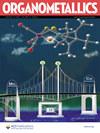钌甲酰基和羟甲基中间体的电子调谐性与可持续的一氧化碳-甲醇转化有关
IF 2.9
3区 化学
Q2 CHEMISTRY, INORGANIC & NUCLEAR
引用次数: 0
摘要
金属甲酰基和羟甲基络合物是碳氧化物(CO2 或 CO)(光)电化学还原为甲醇等液体燃料的关键中间体。甲酰基络合物以及少量羟甲基络合物以前已被合成并表征过;然而,人们对支持这些活性碳片段的配体的电子修饰的影响还不甚了解。在此,我们报告了在双吡啶(bpy)配体(R = OMe、H、CF3)上具有不同取代基的[Ru(4,4′-R,R-bpy)(typy)(CO)]2+形式的钌多吡啶羰基配合物家族的合成。用 NaBH4 作为化学还原剂处理后,形成了甲酰基复合物,随后又形成了羟甲基和甲基复合物;每种复合物都通过全面的核磁共振光谱、质谱和同位素标记研究进行了表征。研究表明,对铋配体进行电子供能修饰(R = OMe)可显著提高甲酰基中间体的寿命和释放出甲醇的产率。我们观察到热力学参数与 bpy 电子学有明显的线性关系;然而,甲酰基络合物的稳定性和由此产生的羟甲基络合物的反应活性与配体电子学没有线性关系。我们预计,这些结果可扩展到未来 CO 转化为甲醇的(光)电催化系统的开发中。本文章由计算机程序翻译,如有差异,请以英文原文为准。
Electronic Tunability of Ruthenium Formyl and Hydroxymethyl Intermediates Relevant to Sustainable CO-to-Methanol Conversion
Metal formyl and hydroxymethyl complexes are implicated as key intermediates in the (photo)electrochemical reduction of carbon oxides (CO2 or CO) to liquid fuels, such as methanol. Formyl complexes, and to a lesser extent hydroxymethyl complexes, have been previously synthesized and characterized; nevertheless, the influence of electronic modifications to ligands supporting these reactive carbon fragments is not well understood. Herein, we report the synthesis of a family of ruthenium polypyridyl carbonyl complexes of the form [Ru(4,4′-R,R-bpy)(tpy)(CO)]2+ bearing different substituents on the bipyridyl (bpy) ligand (R = OMe, H, CF3). Treatment with NaBH4 as a chemical reductant results in the formation of the formyl and subsequently the hydroxymethyl and methyl complexes; each is characterized by comprehensive NMR spectroscopy, mass spectrometry, and isotopic labeling studies. An electron-donating modification (R = OMe) to the bpy ligand is shown to significantly increase the lifetime of the formyl intermediate and the yield of released methanol. We observe a clear linear dependence of thermodynamic parameters on bpy electronics; however, the stability of the formyl complex and the reactivity of the resulting hydroxymethyl complex do not depend linearly on ligand electronics. We anticipate that these results may be extended to future development of (photo)electrocatalytic systems for CO-to-methanol conversion.
求助全文
通过发布文献求助,成功后即可免费获取论文全文。
去求助
来源期刊

Organometallics
化学-无机化学与核化学
CiteScore
5.60
自引率
7.10%
发文量
382
审稿时长
1.7 months
期刊介绍:
Organometallics is the flagship journal of organometallic chemistry and records progress in one of the most active fields of science, bridging organic and inorganic chemistry. The journal publishes Articles, Communications, Reviews, and Tutorials (instructional overviews) that depict research on the synthesis, structure, bonding, chemical reactivity, and reaction mechanisms for a variety of applications, including catalyst design and catalytic processes; main-group, transition-metal, and lanthanide and actinide metal chemistry; synthetic aspects of polymer science and materials science; and bioorganometallic chemistry.
 求助内容:
求助内容: 应助结果提醒方式:
应助结果提醒方式:


